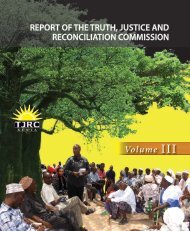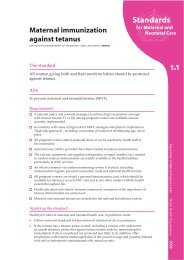MethodologyHuman Rights Watch conducted research between February and November 2011 into thestatus of national investigations and prosecutions for the 2007-2008 post-electionviolence in Nairobi, Rift Valley, Western, Nyanza, and Coast provinces—the provinces mostaffected by the violence. The primary aim of the research was to assess to what extentvictims have been able to access justice for post-election violence and to identifyobstacles that they encountered.Human Rights Watch researchers interviewed 172 people, including 75 victims of postelectionviolence, focusing on those that tried to bring a complaint at the time of theviolence; those involved in court cases that went forward; or those that recognizedperpetrators and would be willing to testify. Researchers also interviewed police,prosecutors, defense lawyers, magistrates, judicial officials, local administrative officials,and local civil society actors concerning the specific challenges to access to justice in eachlocation and in particular cases.Researchers consulted 76 court files in Bungoma, Butere, Eldoret, Kakamega, Kericho,Kitale, Molo, Mombasa, Nairobi, Naivasha, Nakuru, Sotik, and Webuye. They particularlyfocused on high-profile cases involving politicians, police, businesspeople, or otherinfluential citizens and cases involving serious charges, such as murder, robbery withviolence, rape, defilement, and assault causing actual bodily harm.Human Rights Watch submitted a letter to the commissioner of police on June 7, 2011,requesting information on recent progress in investigations, if any; the outcome of anyinternal investigations into the conduct of the police during the post-election violence; andwhether police investigations into sexual offenses during the post-election violence hadresulted in any prosecutions (see Appendix II). The same letter was delivered to theCriminal Investigations Division (CID) of the police on July 13, 2011. Human Rights Watch,in the same letter and in subsequent phone calls, requested meetings with the policecommissioner and the director of the CID to seek their views on the issues raised in thisreport, in the interests of ensuring fairness and balance. Despite promises from the deputypolice spokesperson, as of this writing, no response had been received.Many of the interviews were conducted in English; others were conducted in Swahili,Kikuyu, Kipsigis, Nandi, Dholuo, Luhya, or Sabaot, with the assistance of interpreters.The names of those officials who spoke on condition of anonymity, and of victims andwitnesses who feared repercussions, have been withheld or replaced with pseudonyms.9 HUMAN RIGHTS WATCH | DECEMBER 2011
I. Background: Cycles of Violence and ImpunityPolitical violence in Kenya, along with excessive use of force by security agencies, neitherbegan nor ended with the 2007-2008 post-election violence. The response has beenconsistent both before and after the elections: impunity, spotted with occasional promisesby the authorities to set up investigative commissions. Such commissions have rarelybeen effective: they fail to publish reports, or produce reports that conceal rather thanreveal, and when they do conduct serious investigations, their recommendations arelargely disregarded.Post-independence Kenya’s reputation across the globe as relatively stable and peacefulis not supported by the country’s political history. The series of political assassinationsthat took place under President Jomo Kenyatta’s post-independence regime, from 1963 to1978, was never seriously investigated. Under Daniel arap Moi, Kenyatta’s successor,hundreds of political opponents were tortured, and despite several court decisionsawarding victims compensation, no one was prosecuted for the abuses. 1 Moi’s regime wasalso known for excessive use of force by the state security apparatus. It committed abusesthat may amount to crimes against humanity, as in the case of the 1985 Wagalla Massacre,in which hundreds if not thousands of ethnic Somalis were killed during an operation toseize weapons. 2After Moi agreed under diplomatic pressure to hold multi-party elections in 1992,organized groups affiliated with Moi’s party, the Kenya African National Union (KANU),incited violence against members of the Kikuyu ethnic group in the Rift Valley, whereKikuyus were suspected of supporting the nascent opposition. KANU supporters ralliedKalenjin residents 3 around the idea that Kikuyus were “non-indigenous” and hadappropriated Kalenjin land. 4 They attacked Kikuyus before the elections, to push them outand ensure the maximum number of Moi votes, and after the elections, to solidify claims1 Some victims have been compensated, but only after being “forced … to engage in further court and protracted politicalaction to have the monies released.” Kenya Human Rights Commission, “Surviving After Torture: A Case Digest on theStruggle for Justice by Torture Survivors in Kenya,” 2009, pp. 42, 85-86.2 Billow Kerrow, “The Wagalla Massacre Was a Crime Against Humanity,” Daily Nation (Nairobi), February 9, 2010,http://allafrica.com/stories/201002091141.html (accessed July 19, 2011); “Kenya: Wagalla massacre survivors testify,” April18, 2011, BBC News Online, http://www.bbc.co.uk/news/world-africa-13123813 (accessed November 1, 2011).3 The term “Kalenjin” is a colonial-era construction grouping together at least 10 distinct Nilotic ethnic groups that sharelinguistic and cultural traditions. The largest among them are the Kipsigis and the Nandi.4 Land conflict in the Rift Valley has roots in the colonial area, when British settlers expropriated land from Kalenjins. Afterindependence, President Kenyatta’s regime facilitated the transfer of some of this land to Kikuyus.“TURNING PEBBLES” 10
- Page 1 and 2: Kenya“Turning Pebbles”Evading A
- Page 3 and 4: Copyright © 2011 Human Rights Watc
- Page 5 and 6: 3. Republic v. Charles Kipkumi Chep
- Page 7 and 8: OCSODMOHCHRPEVPNUSBGVSLDFTJRCWKLSOf
- Page 9 and 10: The ICC opened investigations into
- Page 12 and 13: On Further Steps to Address Impunit
- Page 16: on their land. 5 In 1992 a parliame
- Page 19 and 20: violent episode is often considered
- Page 23: • The killing of District Officer
- Page 26 and 27: The task force also visited differe
- Page 28 and 29: objections, including the concern t
- Page 30 and 31: The Department of Public Prosecutio
- Page 32: • An assault case listed among th
- Page 37 and 38: ack to our land.” 107 One impact
- Page 40 and 41: Later the same day, according to po
- Page 42 and 43: trial, the prosecutor presented no
- Page 44 and 45: In Nakuru district, a murder case,
- Page 46 and 47: 2. Republic v. John Kimita Mwaniki
- Page 48 and 49: A murder case in Timbaroa, Republic
- Page 50 and 51: IV. Weaknesses in Investigations an
- Page 52 and 53: Where police arrested suspects, the
- Page 54 and 55: One police officer told Human Right
- Page 56 and 57: witnesses to the court, including t
- Page 58 and 59: put it into effect, but the governm
- Page 60 and 61: there were no investigations into h
- Page 62 and 63: should not necessarily have resulte
- Page 64 and 65:
This would appear to clear the way
- Page 66 and 67:
Most shootings were unlawful under
- Page 68 and 69:
I live in Chebilat Manaret town. On
- Page 70 and 71:
Some semblance of an internal inves
- Page 72 and 73:
justice, they were told either that
- Page 74 and 75:
laborer who washed cars for a livin
- Page 76 and 77:
Police ReformsKey to improving tran
- Page 78 and 79:
Judicial ReformsKenya has made nota
- Page 80 and 81:
expertise the Kenyan judicial syste
- Page 82 and 83:
heard from the police again—check
- Page 84 and 85:
such reparations. Civil society org
- Page 86 and 87:
AcknowledgmentsThis report was rese
- Page 88 and 89:
Bungoma (One court case researched)
- Page 90 and 91:
537/08 Barnabas Tiony Arson Acquitt
- Page 92 and 93:
95/08 Wesley Kipsang Korir Robbery
- Page 94 and 95:
Naivasha (Four court files research
- Page 96 and 97:
182/08 Daniel Moyi Makhopoand Domin
- Page 98 and 99:
Appendix II: Letter to Commissioner
- Page 100 and 101:
95 HUMAN RIGHTS WATCH | DECEMBER 20






